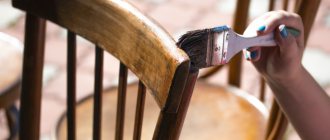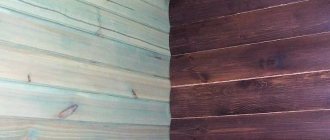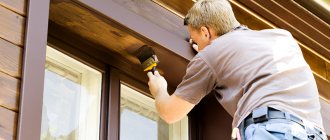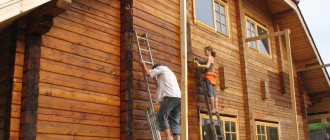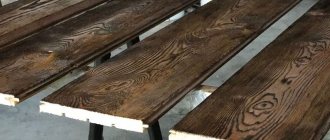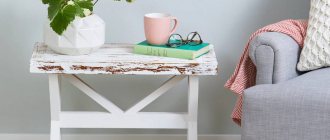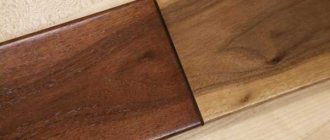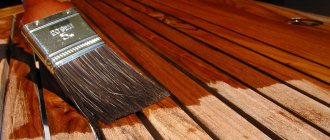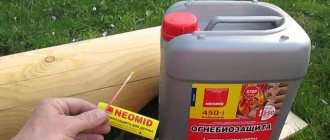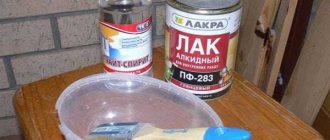Preparing for renovations in the apartment, we come to the problem of selecting paint, thanks to which our design thoughts will come to life. It must meet 3 parameters: safety, high quality, durability. All the mentioned parameters are suitable for polyvinyl acetate paints with a water-based component, or they can also be called PVA. The attractiveness of these paints is due to their balanced composition in price, quality and huge selection. Today, construction stores are ready to provide more than 30 colors with glossy and matte surfaces. The manufacturer focuses on GOST - 28196 89 among the presented paints, which have the best technical characteristics.
Water-based paint for decoration
Calculation of the amount of paint
On the paint label, manufacturers indicate the recommended consumption - the maximum area that can be painted with 1 liter of the mixture in 1 layer.
High-quality compositions that cover a light surface are applied in 2 layers, and to cover the contrasting substrate, the number of repeated applications is increased to 3–4. Porous wall materials can absorb some of the paint, so an additional coat may also be required, as for surfaces with unevenness and defects. When buying paints, the application of which will be accompanied by manual tinting, it is advisable to purchase an additional volume for insurance. In this case, it is recommended to initially mix a large amount of the color coating, since it is almost impossible to achieve an exact match of the shade again.
Properties
Water-based paint is distinguished by a unique application technology. From the point of view of the person applying the paint, the painting process is the same, but at the molecular level there are major changes in composition. Before application, the paint is water with many additives mixed in it. These particles are not dissolved in water, but are simply mixed in it, and being in this state, they do not interact with each other.
When applied to the surface, a significant change in composition occurs:
- the water evaporates, activating the paint particles;
- the binding substances come closer together, turning into an even, homogeneous layer;
- Hardeners impart relative rigidity to the coating.
Considering that the solvent in these types of paints is water, no harmful or toxic substances are released during evaporation. The fire hazard of painting work is also minimized.
Another clear advantage is durability and the ability to apply a new coat directly over old paint. Before applying a new coat, there is no need to carry out special treatment or remove old paint (provided that the old coating was not oil-based).
A negative property of water-based paint is the corrosion effect when pure metal comes into contact with water. But a number of manufacturers, using modern additives, have launched paint production that minimizes such consequences.
Compound
The exact composition will vary depending on the paint manufacturer and its purpose, and is usually kept secret by the company. But, without going into the smallest details, it can be said that any water-based paint consists of the following components:
- 40-60% water and film former dissolved in it;
- 30-40% fillers and coloring pigments;
- 5-10% plasticizers;
- 5-10% other additives.
To create façade paints, antifreeze is always used to withstand negative temperatures, and acrylic resins to impart elasticity to the finished paint layer. Ultraviolet and infrared filters are also used to prevent damage caused by solar activity. Waterproof paint is obtained by adding synthetic rubber or its analogues to the composition.
Best before date
Shelf life directly depends on storage conditions. Manufacturers guarantee complete safety of the product for at least 6 months, the same period is fixed by the current GOST. The paint should be stored in sealed original packaging without exposing it to sunlight. The storage temperature is strictly positive, from +5 to +30°C. Transposition is allowed at negative temperatures, but not more than 1 month.
In fact, the paint can be stored at least twice as long, and some manufacturers still indicate a period of 12 months on the packaging. After this period, the paint will begin to lose its properties, but for local work, many people use 2-year-old remains of already open paint. It is better to comply with the temperature requirements, because a significant part of the paint is water, which can turn into ice.
Viscosity in DIN
According to the current GOST, the viscosity of water-based paints is at least 30din. The vast majority of manufacturers supply paint with a viscosity of 50-60 or more, for subsequent dilution with a solvent. Measurements must be carried out at paint and ambient temperatures within 18-22°C, otherwise the indicators will not be correct.
Depending on the method of applying paint, the optimal viscosity of the composition will change:
- 20-25 when using a spray gun;
- 30-40 for a roller
- 40-50 for a brush.
When diluting water-based paint with water, it is recommended to use only distilled water. Ordinary water from the tap or the nearest body of water is not suitable due to the various impurities it contains. When applying paint with such water to a surface, white marks and stains will remain after the water evaporates.
Why water-based coating?
The simplest method of ceiling repair can be considered the installation of suspended or suspended ceilings. Before carrying out work, no preliminary preparation of the surface is required; this ceiling has an excellent appearance and a fairly long service life. But despite all the advantages, there is also a huge disadvantage - the high cost of a stretch/suspended ceiling. This is due to the high prices of the material itself, and installation is extremely difficult to do on your own, so you definitely can’t do it without involving specialists.
Whitewashing ceilings with lime or chalk emulsion was popular. It would be foolish to deny that this is the most economical and environmentally friendly option - the surface “breathes” well, so the accumulation of moisture and the appearance of mold and mildew certainly does not threaten it. But even here there are a lot of shortcomings - for example, the finished surface is far from ideal in appearance, is a source of dust and quickly becomes dirty, and wet cleaning is strictly contraindicated.
Based on all the facts listed, the most common method of finishing the ceiling is painting with water-based paint. “Simple, cheap and cheerful” is the most accurate definition of this method:
- the price range of the material is extremely moderate;
- without exaggeration, even a teenager can carry out the work independently;
- no special tools or equipment required.
Water-based paint is a suspension of polymer particles and coloring pigment in water. When water evaporates, the solid substances of the base and dye remain on the surface and form a dense protective layer, harmless to the body and also absolutely hypoallergenic - this is another advantage of using water-based paint for finishing ceiling surfaces.
Preparing the Paint
Dilution of paint
The paint in the can has a thick consistency. The undiluted composition is excellent for creating relief compositions, but it is too thick for regular painting. In this regard, the emulsion is first thoroughly stirred, and then water is added to it. The quantity is determined based on the recommendations of the manufacturer or empirically. Water is added until the paintwork reaches the desired consistency. Properly diluted paint resembles the density of full-fat milk.
If you plan to use a spray gun, tap water will not work, since after the coating dries, a whitish coating will form on it. In this regard, distilled water or alcohol is used for dilution.
The paint must be diluted immediately before use. After 15-20 minutes the composition thickens. If this time is missed, the paint should be diluted again.
Tinting
The water-based composition is offered in white. If you want to give the paint a different color, add pigment to it. This can be done at home or directly in the store, if they have specialized equipment.
If you do the tinting yourself, it is recommended to purchase pigment with a reserve of 10-15%. This will allow you to recreate the composition to renew the coating without any problems in the future.
The color is added gradually, after which the solution is thoroughly mixed. If the intensity of the resulting shade is not satisfactory, then you need to add more pigmenting substance.
First, you should dilute a little tinted paint, which will allow you to see how it will look on the painted surface. Moreover, the shade of the dried coating differs from the color of the liquid coating. You also need to keep in mind that paint that has expired or has been stored incorrectly may have a significantly different color (compared to the original) and have poor adhesion to the surface. Poor quality paint forms a bubble coating or simply runs off the surface completely.
Paint consumption
The approximate consumption per m2 is indicated by the manufacturer on the can. Based on these data, it becomes possible to plan the consumption of paints and varnishes.
You can also calculate the amount of paint needed based on the General consumption standards for water-based paints and varnishes:
However, it should be remembered that consumption rates for 1 m2 of the same paint can vary greatly depending on additional factors. In particular, we are talking about the type of material being painted. A smooth surface absorbs 15-20% less paintwork compared to a rough surface.
Note! When calculating, the number of layers is taken into account. Most often, one layer is not enough to paint the surface - you will need at least 2-3 of them
The material consumption is also affected by the tool used. For example, using a spray gun allows you to reduce the consumption of paintwork materials, but only if painting is carried out in calm weather.
Consumption also depends on air temperature and humidity. In hot weather, the liquid quickly evaporates from the dye, and therefore the coating is formed unevenly and layers have to be reapplied. Additional losses of paintwork materials are a common occurrence when painting a ceiling, since the composition simply flows down.
Tools
To apply paint use brushes, rollers or sprayers. Brushes are the best option for finishing small surfaces with many corners and convex details. A spray bottle is a convenient tool, but not everyone has it, and buying it for one painting is not always advisable. Therefore, a roller is often the best method for painting a surface.
There are several types of rollers:
- Foam rubber. They are characterized by low cost. They absorb too much dye, causing bubbles and unevenness to form on the coating.
- Velor. They are more difficult to buy due to their lower prevalence. Velor rollers are characterized by low absorbency. This property has a positive effect on the quality of painting, but you will have to dip the roller very often.
- Fleecy. The best option for painting. There are rollers on sale with different lengths of pile (affects the thickness of the layer). The most expensive fleecy rollers are made from felt and fur. Polyamide fiber rollers are also a good choice.
Details
Characteristics and composition of paintwork
As mentioned earlier, polyvinyl acetate compositions differ in drying speed. By the way, water-based compositions dry out in about a couple of hours, provided that the air temperature is +17....+24 degrees. The reason for the rapid hardening is that the emulsion contains up to 40% water, which will easily evaporate after application to the surface to be treated. The emulsion also contains up to 60% resins and pigmentation substances. If there is a need to reduce the viscosity of the product, water should be added to it and even vice versa.
During evaporation, resin particles (and their size can range from 1 to 4 microns) first approach each other and create a dense ring around the pigments, and then completely merge with them. The result is a fairly dense mass made of resin and pigments. The mass has extremely small pores through which water will evaporate. The mass has fairly small pores through which water will evaporate. After the dyeing process, the water eventually evaporates and the plasticizers become hard and even hydrophobic.
After drying, the film will decrease in size - to approximately 60% of its original volume. Since the surface of the film has a lot of pores, it also has a slightly silky and matte sheen. Thanks to this, the painted surface will impart excellent decorative properties. In many cases, subject to proper painting techniques, polyvinyl acetate paint can easily replace matte oil-based coatings. Polyvinyl acetate products may come with appropriate tinting options. The use of tinting substances is required in accordance with the instructions from the manufacturer.
Acrylic water-dispersion paints
Due to the use of acrylic polymers, the improved composition of polyvinyl acetate paint can be used to apply to external facades, as well as to treat surfaces in wet rooms (for example, a bathroom or kitchen). To make coatings shiny/dull, special types of additives are used.
Applying paint and varnish material to the surface
Painting using water-based polyvinyl acetate compositions is carried out in the following sequence:
- We select the most suitable paint type material for the existing conditions.
- Carry out a set of preparation measures before painting the surface - remove dust and dirt, repair all defects (cracks, seams, bumps, etc.), remove the whitewash layer, if any. To save on paint and varnish material and improve adhesion, it is recommended to prime the surface.
- Stir the polyvinyl acetate paint and varnish material well, remove pre-dried lumps from the container. Dilute the water-based mixture.
- Apply paint with a roller, brush or spray.
- Wait for the first layer to dry and apply the next one. If necessary, the procedure should be repeated even a third time.
There are a few more nuances left to consider.
Features of the compositions
When choosing paint and varnish materials for renovation of premises, you should know that they may differ in their characteristics, have different compositions, and from different manufacturers. Some types of materials can only be used indoors, others are used both indoors and for painting walls outside.
The basis of water-based paint is water, to which mineral components are added. After the water dries, a durable film is formed, which protects the surface from external negative influences and makes the walls and ceiling attractive.
The final result depends on what paint you use. We can distinguish the following types of paints and varnishes, which differ in their components:
- Mineral paint. It is made by adding lime or cement to the composition. It is inexpensive, easy to apply, but quickly begins to fade under sunlight and is easily damaged.
- Silicate - it is produced using liquid glass. This paint can be used to paint a room inside and outside, as the material is resistant to sunlight and has increased water resistance. By painting the walls with this paint, you can forget about repairs for 10 years, the material will retain its color.
- Acrylic paints. They are recommended to be used in a dry room; for greater moisture resistance, latex is added to the material. After using this material, a flat, smooth surface is obtained; in the process, minor cracks on the walls are healed.
- Using silicone paint, you can combat cracks on larger walls, up to 2 mm. The material is quite expensive, but has many advantages: the paint lies smoothly on the surface, allows water vapor to pass through, and retains its quality for a long time.
- For repair work, you can use polyvinyl acetate paints, which have many advantages. They are used for finishing porous materials such as wood, cardboard, and plaster. The material dries quickly, has no ingredients harmful to health, adheres well to the surface, and after drying an excellent result is obtained.
What is the difference between water-based PVA and dispersion PVA?
Polyvinyl acetate paints are characterized by the following features:
- do not contain solvents;
- no unpleasant odor;
- after drying, an elastic coating is formed;
- absorbs well into different materials.
Such dyes are used only for interior work. Water-based PVA is available in white color, and therefore materials of this type must be mixed with appropriate pigments.
Polyvinyl acetate paints are not used in rooms with high humidity. Dispersion compositions in this vein look preferable, since they contain special components that:
- increase moisture resistance;
- increase resistance to external influences;
- promote the formation of a vapor-permeable layer;
- impart hydrophobic properties to the original composition.
Dispersion dyes are universal. That is, such compositions can be used when finishing various rooms, including kitchens and bathrooms.
Main types of water-dispersed paints based on bases and their characteristics
Developers annually offer dispersions with new inclusions and binding components. Relatively new proposals include some decorative emulsion and water-dispersion paints that form an unusual texture, for example, imitating stone. They are applied to any primed substrate, including wood and metal.
Modern water-based enamels are classified by type of application:
- Facade;
- Interior.
They contain common components, for example, to protect against mold and mildew, but they all differ in composition and characteristic properties. There are also latex and hammer compounds with special effects.
Developers annually offer dispersions with new inclusions and binding components.
Polyvinyl acetate
PVA-based paints are characterized by low hydrophobicity, so they should not be used in damp rooms. They are suitable for painting plastered ceilings in an apartment with a stable temperature regime. This is a budget option for cosmetic repairs.
They are suitable for painting plastered ceilings in an apartment with a stable temperature regime.
Acrylate
Dispersion paint with the addition of acrylates remains the most popular due to its optimal price-quality ratio. It is resistant to UV rays, so it is recommended for interior use even on the south side. A vapor-permeable elastic coating is also guaranteed.
The waterproof composition is easy to use, the layer does not crack even with a noticeable temperature difference. But this does not mean that you can experiment as facade coatings if the packaging says “for interior use.” The advantage is a perfectly flat surface after painting, regardless of the base material.
The waterproof composition is easy to use, the layer does not crack even with a noticeable temperature difference.
Latex or styrene butadiene
Styrene-butadiene dispersed compositions are moisture resistant, but their pigment quickly fades when exposed to sunlight. The interior is the place to be. These are latex compounds based on synthetic and organic rubber-type resins that look great after drying.
Application - bathrooms, bathtubs and showers, as they perfectly resist dampness and are easy to clean. You can paint insulated attics, basements and wine cellars. The walls of glazed loggias and balconies are quite acceptable, provided that a dim shade is used (the polymer quickly fades in the sun).
Application - bathrooms, bathtubs and showers, as they perfectly resist dampness and are easy to clean.
Silicone
If we talk about what silicone water-dispersion paint means, then it is worth focusing on its specialization. Known to specialists as a façade dye of excellent quality. These mixtures are distinguished by their ability to repel dirt and water, cleaning the wall during rains. Therefore, the building near the road will remain clean even in bad weather.
The coating will protect the walls from any influences, while maintaining high aesthetics and uniform processing. With this composition, specialists work on basement and facade surfaces - brick, concrete and plaster. It is noteworthy that matte and glossy variations are offered for facade work.
The coating will protect the walls from any influences, while maintaining high aesthetics and uniform processing.
Dispersive silicate
Silicate dyes are also water-based. Liquid glass and sodium ethyl silicate in its composition explain their name and classification - mineral paints. Main varieties:
- Dispersed silicate (acrylic added);
- Silicate-silicone.
The basic requirements for compositions and their properties are regulated by GOST.
Silicate dyes are also water-based.
Application area
Polyvinyl acetate paint is used in many areas, as it is elastic and is not usually exposed to external irritants. Due to the ease of use of the solution, you can use it yourself, without construction organizations. However, regardless of this, it should be noted that attention must be paid to the surfaces on which the pigment can be used. The solution is typically used when applied to materials:
- Tree.
- Concrete and brick.
- Drywall.
- Glass.
- Plaster.
Pay attention to: Kitchen paint: types of paint and varnish compositions, wall preparation and painting instructions
You can apply the solution to the oil layer. You can do the same with metal, first coat it with an oily liquid. However, be careful when using the product over primer. It is not suitable for all brands.
Painted drywall
Painted glass
painted wood
Specifications
To describe the water-based composition, the following factors are important:
- Paint components. The aqueous solution can contain a variety of fillers, thickeners, and antiseptic substances. Depending on the composition, the paint is intended for facade or interior work, wet or dry rooms, etc.
- Scope of use. The composition can be universal or for painting only one type of surface (for example, wood).
- Consumption of paint and varnish composition. The amount of paint in milliliters is calculated based on how much it is needed to cover 1 square meter in one layer. At the same time, many factors are taken into account, including the type of material and surface condition.
- Specific gravity. High-quality water-dispersion paint has a density of approximately 1.5 kg per 1 liter.
- Viscosity. This parameter indicates the degree of dilution with liquid.
- Ambient humidity during application and operation.
- Drying time.
- Storage conditions.
- Best before date.
- Service life of the coating.
There are other technical details to know, including the proportions of paint components and common markings.
Note! Water-based paint is always white, and colored paint is obtained by adding a special pigment
Component proportions
An important component of water-based paints is the emulsifier, which is responsible for the formation of the film.
The following components are used as film formers:
- styrene-butadiene;
- acrylic resin;
- polyvinyl acetate;
- styrene acrylate.
Mica, barite, talc, and chalk are also added to the composition. The proportions in which certain components are contained in the paint are determined by its purpose.
The function of a thickener is performed by a complex compound - carboxymethylcellulose. In common parlance, this component is called CMC adhesive.
Note! To work with emulsion paint, it is recommended to use a spray bottle. Spraying allows you to get the highest quality and uniform coverage
The table shows the ratio of various components in water-based paint:
Water-based paint and varnish material is made by adding a white pigment substance, for example, zinc oxide or titanium dioxide.
According to the main component, all water-based dyes are divided into several types:
- silicate;
- acrylic;
- silicone;
- mineral.
Marking
Abbreviated letters and numbers are used on the paint can or in accompanying documents. First there are letters indicating the type of composition:
- VE – water-based paint;
- VD – water-dispersed.
The following letters indicate the type of polymer used:
- KCh (butadiene-styrene);
- VA (polyvinyl acetate);
- AK (acrylate or styrene acrylate);
- VS (polyvinyl alcohol).
In addition to letters, numbers are used:
- 1 - compositions that are especially resistant to atmospheric conditions;
- 2 - paints for interior work.
Note! Requirements for water-based coatings are set out in GOST 281960-89. Unlike GOST, the rules of specifications are much less stringent, and therefore the quality of products manufactured according to specifications cannot be guaranteed
Advantages and disadvantages
Water-based paints have many positive qualities:
- Good adhesion to different types of materials.
- Easy to dilute in water.
- Environmental Safety.
- Fast drying.
- No unpleasant odor in the room after painting the surface.
- Strength. The coating does not peel off.
- Resistant to chemicals, including alkalis.
- Easy to remove dirt from the coating.
- Fire safety.
- High water resistance of individual modifications, which makes it possible to paint surfaces in bathrooms and kitchens with such compositions.
- Antibacterial properties.
- Long service life of the coating, reaching 18-20 years.
- The ability to mask surface defects (with the proper level of viscosity of the composition).
- Compatibility with any type of interior. Thanks to tinting, the paint has a wide range of colors.
- Low cost.
Water-based paints also have disadvantages:
- Temperature sensitivity when dyeing. The minimum threshold is 5 degrees above zero.
- Some types of paints do not form very durable surfaces.
- Not all water-based compounds are suitable for metal substrates or glossy surfaces.
Characteristics of water-based paint depending on the type of film former
Five types of film formers can be used as a binding polymer in water-based paints, which largely determine the advantages and disadvantages of a particular type of paint.
Water-based paints based on polyvinyl acetate are considered to be of the lowest quality. Such paints are labeled “VD-VA” and have a very narrow scope of application. These paints are not used for domestic purposes during repairs or construction, since over time they turn yellow, and the painted surface is covered with a dense and opaque film. In addition, VD-VA paints are non-waterproof.
Unlike PVA-based paints, water-based styrene-butadiene paints are resistant to moisture, but also form a dense film and do not withstand exposure to sunlight. To mark these paints, the abbreviation “VD-KCH” is used.
Paints based on styrene acrylate are labeled “VD-AK”. These paints are significantly superior in quality to PVA and styrene-butadiene paints, which allows them to be applied to external and internal surfaces. Due to the small size of polymer particles, VD-AK paints have excellent adhesion to almost all types of surfaces, and the penetration of particles into the pores of the surface being painted increases strength. Such paints form a porous coating that is resistant to moisture and solar radiation.
Types and technical characteristics
What all water-based paints have in common is a water base and an emulsion type of coloring pigment. Paints are distinguished by the composition of the binder, which provides the desired characteristics for a specific application. The most common types of water-based paints are:
- acrylic;
- silicone;
- silicate;
- mineral;
- latex.
Paint consists of purified water, which acts as a solvent, a color filler containing one of the above bases, as well as various plasticizers and additives.
Apart from the binder, the main differentiating characteristics of paints are:
- water permeability;
- density;
- application area.
To ensure that the paint dries quickly after application, special hardeners are used. Depending on the expected operating conditions, thickeners or antifreeze-based additives are added to the composition.
VEAK
VEAC 1180 paint is one of the most common types of water-based paints. This type of paint is produced in accordance with GOST 28196-89, according to the requirements of which all products meet the following characteristics:
| Density | 1.4 g/cm |
| Viscosity | From 30 s/m |
| Drying time | 1 hour |
| Abrasion resistance | 3.5 µm/kg |
| Mass fraction of non-volatile compounds | 53%-59% |
| PH | 6,8-8,2 |
This is an acrylic-based paint used for interior finishing work. All paint of this type is exclusively white, but, thanks to the possibility of tinting, it can acquire any color and shade.
Water-based acrylic
Acrylic-based paints are universal and include a whole group of varieties classified according to OKPD 2 number 20.30.11.120. This paint is used indoors and in facade work. At the same time, acrylic base is the most expensive of water-based paints.
Acrylic paint is very durable, service life varies from 5 to 20 years. The paint is applied to almost any surface, evenly distributed over the plane. After drying, the paint creates a fairly dense layer that is poorly permeable to air and other substances. Also, a strong advantage of this base is its high frost resistance and resistance to temperature changes.
Latex
Latex paint contains rubber, which gives the applied layer elasticity. This type is also used both indoors and outdoors. Paint comes in different types, and is divided not only by area of application, but also by the characteristics of the finished surface in terms of gloss. There are:
- SM completely matte;
- M matte;
- MP half matte;
- PG half glossy;
- G glossy;
- SG is completely glossy.
This type of paint is used to create a three-dimensional texture of the painted surface. Like acrylic paint, latex paint easily tolerates contact with water after the surface has completely dried.
For concrete for outdoor work
Most water-based paints for exterior use are based on acrylic, latex or silicate, including those for concrete work. Such coatings not only have a decorative function, but also protect concrete from moisture and ultraviolet radiation.
The paint is applied in a dense layer and fills all minor surface irregularities, forming an even, uniform layer. Facade paint for concrete must have the following characteristics:
- high rate of adhesion, that is, “sticking” to the surface;
- strong moisture resistance;
- high abrasion;
- UV resistance;
- vapor permeability, to allow the evaporation of water and other substances from concrete;
- high resistance to dirt.
For outdoor woodworking
For such types of work, the requirements for paint will be even stricter, because wood, unlike concrete, is susceptible to rotting. If you use paint that allows water to pass through or, even more so, absorbs it, the surface will quickly become unusable, and this will affect not only the appearance, but also the strength of the structure as a whole.
The general performance of paints will be the same as for concrete, but paints made specifically for wood will be easier to apply and will last better. Today, there are water-based coatings with antifungal additives that provide additional protection.
Polyvinyl acetate dispersion
Polyvinyl acetate dispersions are manufactured with particle sizes of 1 - 3 microns. Polyvinyl acetate dispersions are produced both unplasticized - grade D 50N, and plasticized - grade DB 48 / 4C with the addition of 4% (wt.) dibutyl phthalate. These are viscous liquids of white color, without lumps or foreign inclusions; The presence of a surface film is allowed.
| Standardized indicators of polyvinyl acetate dispersions. |
Polyvinyl acetate dispersions are used to produce water-based paints (more precisely, water-dispersion or latex paints) for painting plaster; concrete, wood, primed metal surfaces indoors and outdoors.
| Technological scheme for the production of emulsion polyvinyl acetate in a continuous manner. |
Polyvinyl acetate dispersions are also prepared batchwise in a reactor with continuous stirring and a temperature of 65 - 75 C. Unpolymerized vinyl acetate is distilled off under vacuum. The resulting dispersion is transferred to a mixer, where a plasticizer and, if required, other components are added.
The polyvinyl acetate dispersion from the last reactor in the cascade flows by gravity into horizontal mixers 26, operating alternately (one mixer is conventionally shown in the diagram), in which the dispersion is neutralized with an aqueous solution of ammonia and brought to the required viscosity with water. If necessary, plasticization of the dispersion is also carried out in these mixers.
Polyvinyl acetate dispersion is prepared by polymerizing the monomer - vinyl acetate - in an aqueous medium. Vinyl acetate is emulsified in water with the help of a suitable emulsifier and in the presence of a protective colloid. Then, with the help of a water-soluble initiator (hydrogen peroxide), the monomer is polymerized. The heat generated during polymerization can be easily removed, since the resulting dispersion has a relatively low viscosity and is therefore easily mobile. Plasticizers interfere with the polymerization process and therefore are mostly introduced into the finished dispersion. In principle it is also possible to dissolve the solid polymerized resin in a suitable solvent and then disperse it in water. However, such a process is complex and therefore has only limited application.
Polyvinyl acetate dispersion contains about 50/0 resin and plasticizer (the content of the latter can reach 50 parts by weight per 100 parts by weight of resin), the rest is water.
Polyvinyl acetate dispersion (emulsion) is used at normal temperature (without heating) for gluing the spine of a book block, including without sewing, for covering brochures with covers and for other work. The dispersion can be diluted with water. The glue dries quite quickly as a result of the paper absorbing the dispersion medium (water) and the resin particles sticking together into a continuous film, as well as due to the evaporation of a certain amount of water.
Polyvinyl acetate dispersions are manufactured with particle sizes of 1 - 3 microns. Polyvinyl acetate dispersions are produced both unplasticized - grade D 50N, and plasticized - grade DB 48 / 4C with the addition of 4% (wt.) dibutyl phthalate. These are viscous liquids of white color, without lumps or foreign inclusions; The presence of a surface film is allowed.
| Standardized indicators of polyvinyl acetate dispersions. |
Polyvinyl acetate dispersions are used to produce water-based paints (more precisely, water-based or latex paints) for painting plaster, concrete, wood, and primed metal surfaces indoors and outdoors.
Homopolymeric polyvinyl acetate dispersions, when dried, form brittle films that are cloudy or slightly opalescent due to the incompatibility of polyvinyl acetate with polyvinyl alcohol used as a protective colloid. The introduction of certain additives, such as maleic anhydride, into the plasticized dispersion during the manufacturing process gives it frost resistance.
Polyvinyl acetate dispersion of the NV brand (low-viscosity) is used as an adhesive in the manufacture of clothing and footwear, as well as food containers.
A typical polyvinyl acetate dispersion is, for example, Gelva TS 30, containing 50 - 56% solids, having a pH of 4 - 6 and a viscosity of 4.6 - 6.5 poise. Dispersions with small particle sizes include commercial products Polyco 895 - 30 and Darex Polymer V. Rhodopas and Novyl dispersions are fundamentally different in that the first of them is an oil in water type and the second is water in oil. It can be diluted with water in all respects. The dispersion can also be mixed with rubber latex and casein solutions.
Painting with polyvinyl acetate water-based compositions
Ceiling and wall surfaces are painted with polyvinyl acetate water-based emulsion in the following order:
- Check the alignment of the paint with the surface being treated.
- The working area is cleared of dust and dirt.
- Clean off the old plaster, check the strength of the old sealing of cracks and seams.
- Apply putty over cracks and grooves. Allow to dry. Clean with sanding.
- Whitened surfaces are washed down to the base with a soap solution. Let it dry. Seal up the cracks.
- At low temperatures, warm the paint container to room temperature.
- Open the container with the dye, remove the dried film, mix the contents until smooth.
- Depending on the method of application: with a brush or spray gun, dilute with the volume of water indicated on the label. Stir until smooth.
- For tinting, part of the dye is cast, a coloring agent is added to the container, and a volume of 10-15% more than planned is prepared. In case of overspending, choosing a shade is not easy. It is better to immediately prepare an excess amount of colored solution.
- To save paint consumption, treat the work area with a primer mixture.
- Apply the prepared composition to the surface.
The video tutorial will help you paint walls with polyvinyl acetate water-based paint professionally:
Today it is difficult to imagine renovation without the use of paints and varnishes. Water-based paint has gained particular popularity.
, which is suitable for exterior finishing of facades and interior work. The composition fits perfectly on any type of surface: wood and brick, concrete, plaster, etc.
Reasons to buy water-based paint
There are many reasons that make water-based paint so popular. We are talking about its high technical and operational characteristics:
- ease of use;
- quick drying;
- no unpleasant odor;
- high degree of hiding power;
- efficiency;
- fire safety;
- environmental cleanliness and hygiene.
Water-based paint forms a waterproof film on the surface, preventing moisture from seeping inside. At the same time, the material retains the ability to “breathe”.
Water-based paint: where to use it
Before you buy water-based paint
, it is necessary to determine the type of surface to be painted. Thus, latex-based compositions are suitable for application to textured wallpaper, plaster or cement. But acrylic acid is considered universal.
In some cases, water-based paint is enriched with special additives (including antiseptic ones). This increases its durability and provides additional protection for the coating.
Today it offers its customers a wide range of paint and varnish products. From us you can buy water-based paint of the required color. We guarantee high quality of all products, as well as their prompt delivery and reasonable prices.
Polyvinyl acetate paint is used for interior and exterior decoration of residential and industrial premises. It is designed to work with plastered, concrete, plaster and wooden surfaces. Also fits well on a layer. For painting you can use a brush, roller or spray gun.
Features of the material
Before purchasing, you need to study some basic indicators of this composition:
- Viscosity is a characteristic of a substance, which is determined by the degree of concentration of water in the paint. The indicator is measured with a viscometer. To use a roller or brush, the viscosity should be 40–45 St. If the composition is applied using a spray gun, then no more than 25 Art.
- As for consumption, we can’t say for sure. The average is 180 ml per square meter. But this amount may vary depending on the characteristics of the surface being treated, the tools used and the quality of the paint. The specific gravity of the material is 1.4 kg/l.
- Drying time ranges from 2 hours to a day. This difference is explained by the fact that in damp rooms and without proper ventilation, water evaporates less intensely. The recommended operating temperature is 20 degrees Celsius and air humidity is 70%.
- The shelf life of water-based paints is limited to 24 months from the date of production. Once opened, the paint should be stored in a cool, dark place and should not be allowed to freeze.
Correct application
Correct adherence to a certain order in performing work is the key to success. This must also be observed when painting:
- first you need to make a choice of a certain type of coating (it all depends on the conditions of application and operation);
- then preparatory work will be required: removing dust and whitewash, leveling and eliminating cracks;
- primer;
- preparation of paintwork materials;
- applying paint and varnish to the surface;
- When applying the second layer, it is necessary to wait until the first layer has completely dried to identify unpainted areas and other defects.
Thus, polyvinyl acetate water-based paint does not belong to universal finishing materials. However, the range of her work is quite wide. The price of these compounds is pleasing to the eye, given the high quality and constant compliance with GOST. Thanks to this paint, anyone can do repairs, not just a professional painter.
From the following video you will learn the secrets of ideally preparing walls for painting.
Applying paint
The prepared paint and varnish material is poured into a painting tray. To make painting more convenient, reaching to the most remote areas, a long handle is attached to the roller. For this purpose, use a plastic tube or a light wooden holder.
Apply paint starting from the corner of the wall. Moreover, it is painted over with a brush. Then they dip the roller into the paint, press it onto the pallet and make movements downwards and then up. The thickness of the applied strip is equal to the width of the roller. Each subsequent strip is overlapped with the previous one. In this way, visible boundaries between the stripes are avoided. You need to paint quickly in order to have time to use up all the diluted paintwork.
Apply 2-3 layers of water-based composition to putty walls. Each time they wait until the coating dries, and only then begin to apply a new layer. On average, the break is 3-4 hours.
Note! When applying paint to wallpaper, one layer is enough

